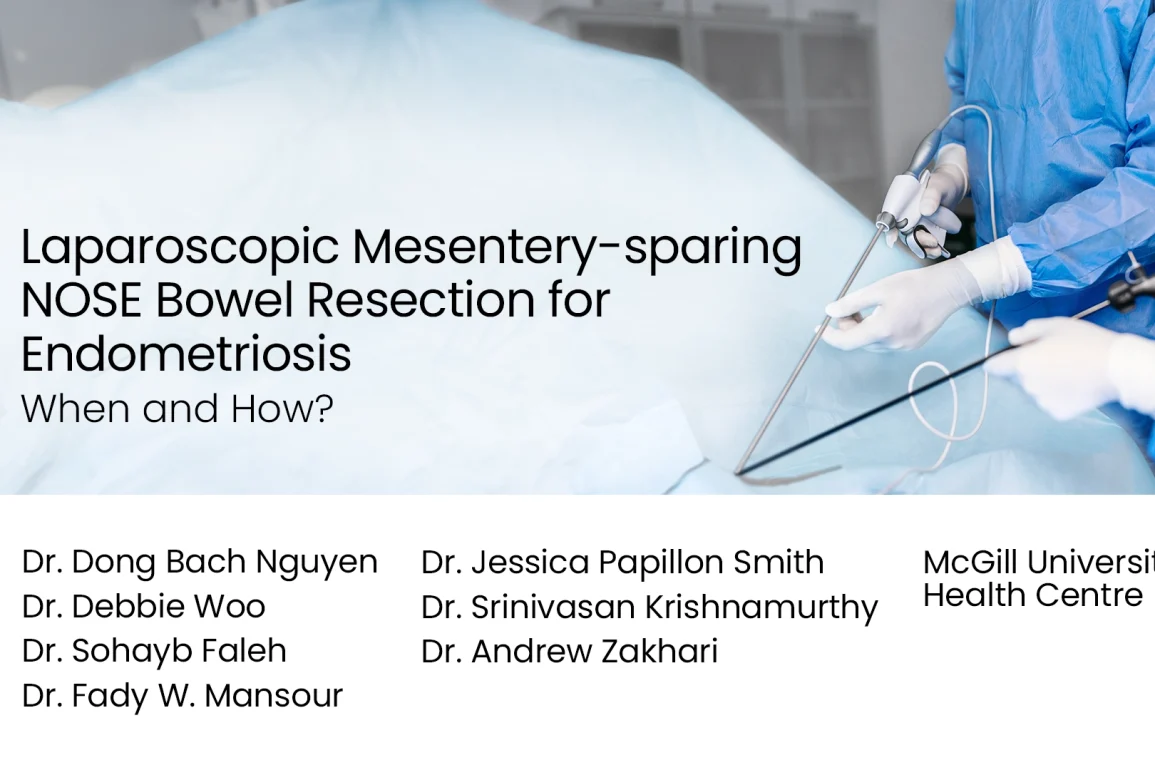Table of Contents
- Procedure Summary
- Authors
- YouTube Video
- What is Laparoscopic Mesentery-sparing NOSE Bowel Resection for Endometriosis?
- What are the Risks of Laparoscopic Mesentery-sparing NOSE Bowel Resection for Endometriosis?
- Video Transcript
Video Description
A detailed guide to laparoscopic mesentery-sparing natural orifice specimen extraction (NOSE) bowel resection for endometriosis—when to use it and how it’s done.
Presented By
Affiliations
McGill University Health Centre
Watch on YouTube
Click here to watch this video on YouTube
What is Laparoscopic Mesentery-sparing NOSE Bowel Resection for Endometriosis?
Laparoscopic mesentery-sparing NOSE bowel resection is a minimally invasive technique used to remove deep colorectal endometriosis while preserving mesenteric blood and lymphatic supply and avoiding an abdominal incision. Here’s what it involves:
- Preoperative Imaging and Planning: Dedicated transvaginal ultrasound and MRI define lesion size, depth of bowel wall infiltration, distance from the anal verge, and the degree of luminal stenosis to guide the surgical plan.
- Pelvic Mobilization and Exposure: The posterior compartment is mobilized, endometriomas are drained if present, and the ovaries may be temporarily pexied to the abdominal wall to improve visualization.
- Ureterolysis and Nerve Preservation: Bilateral ureterolysis is performed to prevent distal ureteric injury, and the hypogastric nerves are carefully lateralized to maintain nerve integrity.
- Mesentery-sparing Dissection: The bowel mesentery is dissected circumferentially off the rectosigmoid segment to free the diseased bowel while preserving vascular and lymphatic pathways.
- Segmental Resection: Proximal and distal margins of the diseased segment are defined, and enterotomies are created to allow insertion of the anvil for stapled anastomosis. The diseased bowel is divided with a linear stapler and completely excised.
- Natural Orifice Specimen Extraction (NOSE): The resected bowel segment is removed through the rectum, avoiding a mini-laparotomy and reducing postoperative pain and recovery time.
- Primary Anastomosis and Leak Test: The circular stapler is introduced transrectally to create the anastomosis, followed by a rigid sigmoidoscopy and air leak test to confirm integrity.
This approach combines precise laparoscopic dissection with natural orifice specimen removal to reduce abdominal trauma while ensuring complete excision of deep colorectal endometriosis.
What are the Risks of Laparoscopic Mesentery-sparing NOSE Bowel Resection for Endometriosis?
Despite its minimally invasive design, this procedure carries important risks.
- Anastomotic Leak: Leakage at the bowel connection can lead to peritonitis, abscess, or the need for reoperation or diverting stoma.
- Bleeding: Dissection of the bowel wall and mesentery can cause significant hemorrhage requiring transfusion or conversion to open surgery.
- Injury to Adjacent Organs: The ureters, bladder, and pelvic nerves are at risk during mobilization and dissection, which can lead to urinary or neurologic complications.
- Bowel Dysfunction: Temporary changes such as diarrhea, constipation, or low anterior resection syndrome may occur postoperatively.
- Infection and Pelvic Abscess: Bowel surgery carries a risk of postoperative infection or abscess formation despite meticulous technique and ERAS protocols.
- Stricture or Stenosis: Scar formation at the anastomosis can narrow the bowel lumen, causing obstructive symptoms that may require dilation or reoperation.
- Recurrence of Endometriosis: Even after complete resection, microscopic disease can persist, leading to recurrence of symptoms.
Careful preoperative imaging, multidisciplinary planning, and precise laparoscopic technique are essential to minimize these complications while achieving complete disease removal and functional bowel restoration.
Video Transcript
In this video, we describe when and how to perform a laparoscopic bowel resection for colorectal endometriosis. In cases of multi-organ endometriosis gynaecologic surgeons must remain at the forefront of clinical decision making and surgical care coordination.
The technique presented is nerve-sparing, mesentery-sparing, and utilises the NOSE approach, where the anvil and specimens are transferred through natural orifices to avoid a mini-laparotomy. Bowel endometriosis affects eight to 12% of patients with endometriosis, and most commonly involves the rectosigmoid colon. Over 90% of colorectal lesions can be identified on a dedicated transvaginal ultrasound. Rectosigmoid nodules appear as a hypoechoic lesion that can be identified by following the hypoechoic muscularis layer of the anterior rectal wall.
MRI may be used to further characterise the lesions and rule out more proximal implants. Imaging should describe the size of the lesion, depth of infiltration, distance from the anal verge, and estimated degree of stenosis. When assessing depth of the infiltration of the nodule, it is important to define which of the four bowel layers the lesion is infiltrating. Lesions superficial to the muscularis layer can be excised by rectal shaving.
On the other hand, for deep lesions infiltrating the muscularis or more, a complete excision usually requires a full-thickness removal of the bowel wall. This can be achieved with either a disc excision or a segmental resection. For deep lesions disc excision is preferred when feasible, given the lower risk of complication.
Segmental resections are therefore usually reserved for the following indications. The surgical steps should be kept systematic and start with a mobilisation of the posterior compartment, followed by the mesenteric dissection, or resection of the diseased bowel segment, and the primary re-anastomosis.
Examination of the pelvis shows a normal-sized uterus, along with the left endometrioma adherent to the left uterosacral ligament. Large endometriomas often obliterate the pouch of Douglas and must be drained and released to allow visualisation of the posterior cul-de-sac. Ovaries can be pexied temporarily to the interior abdominal wall using a suture on a straight needle to optimise exposure.
A bilateral ureterolysis is necessary in order to prevent distal ureteric injury at the time of stapler applications. An attempt should be made at lateralising the hypogastric nerve. When present, uterosacral ligament or parametrial lesions can be excised at this step.
To define the borders of the rectum, the pararectal spaces are dissected on either side of the rectal wall. This allows to isolate the rectal uterine fibrosis that most often lies in the midline. The rectal nodule can then be shaved from the posterior uterus, leaving disease on the bowel. The shaving is pursued until the healthy rectovaginal space is encountered.
The segmental resection can now be performed. Here, we use a mesenteric sparing technique to avoid the unnecessary disruption of vascular and lymphatic supply to the rectosigmoid colon. The bowel mesentery is dissected off of the bowel wall, starting at the proximal edge of the lesion, and moving circumferentially until the fenestration is achieved posteriorly. The dissection is pursued caudally and ends when the distal edge of the lesion is reached. If needed, the sigmoid colon can be mobilised to avoid tension on the anastomosis.
Two rectal enterotomies are performed next, as shown by the dotted lines. The first enterotomy is performed near the distal margin of the nodule for the insertion of the anvil. A second enterotomy is performed at the proximal margin of the nodule for the anvil’s later placement. Through the distal enterotomy, the anvil is inserted inside the abdomen. The anvil is then passed through the proximal enterotomy and is secured to the healthy proximal bowel edge by piercing the sharp tip through the interior rectal wall.
The diseased segment of bowel is divided from the proximal colon using a linear stapler. The segment is then divided from the distal colon sharply, and the specimen is removed through the rectum. The distal healthy colon is closed with a linear stapler and the small segment of diseased bowel is removed through a laparoscopic trocar.
The circular stapler is inserted rectally and secured through the rectal stump, any excess mesentery is trimmed off, the anvil tip is removed, the two ends of the circular stapler are secured, and the anastomosis is completed. Care must be taken to avoid any twists in the proximal bowel, as well as any tension on the anastomosis. The procedure ends with a rigid sigmoidoscopy to ensure a negative air leak test.
Preoperatively, a bowel preparation is required for a NOSE technique. Post-operative care should follow the ERAS pathway for colorectal surgery. Planning a successful NOSE bowel resection relies on accurate preoperative imaging and a multidisciplinary surgical approach.




